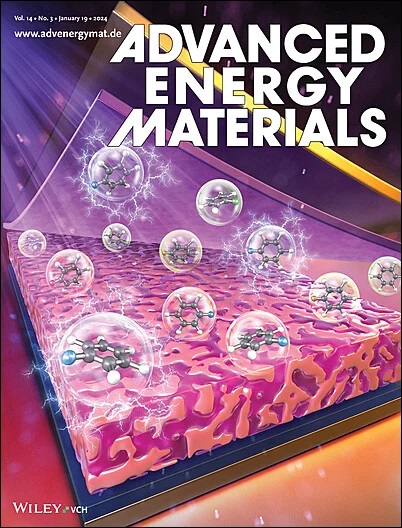Engineering Ruthenium Species on Metal–organic Frameworks for Water Electrolysis at Industrial Current Densities
IF 24.4
1区 材料科学
Q1 CHEMISTRY, PHYSICAL
引用次数: 0
Abstract
Developing highly active and stable electrocatalysts for hydrogen production at industrial current densities is pivotal to give an impetus to carbon neutrality. Recently, metal–organic frameworks (MOFs) with large surface area and adjustable structures have become a class of promising alternative electrocatalysts, while their low conductivity and poor stability limit their widespread applications. Here, a modified strategy is proposed to stabilize and modulate Ruthenium (Ru) species including Ru single atoms (Ru SAs) and Ru nanoparticles (Ru NPs) on MOFs for enhanced hydrogen evolution reaction (HER). Benefiting from the strong interaction between Ru and MOFs, the synthesized NiFeRuSA+NP-DOBDC (DOBDC: 2,5-dioxido-1,4-benzenedicarboxylate) exhibits an extraordinary HER performance with overpotentials of 25 and 271 mV at 10 and 1000 mA cm−2, respectively. Meanwhile, it enables robust HER at a high current density of 1 A cm−2 over 300 h. Remarkably, the assembled anion exchange membrane (AEM) electrolyzer realizes a low voltage for alkaline water electrolysis. In situ analyses demonstrate that NiFeRuSA+NP-DOBDC enables optimized H2O adsorption and dissociation, and theoretical calculations indicate that Ru SAs and NPs accelerate the Volmer-Heyrovsky pathway, synergistically promoted the HER performance. This work presents a competitive strategy to integrate supported metal species on the MOFs platform to efficiently drive industrial water electrolysis.

求助全文
约1分钟内获得全文
求助全文
来源期刊

Advanced Energy Materials
CHEMISTRY, PHYSICAL-ENERGY & FUELS
CiteScore
41.90
自引率
4.00%
发文量
889
审稿时长
1.4 months
期刊介绍:
Established in 2011, Advanced Energy Materials is an international, interdisciplinary, English-language journal that focuses on materials used in energy harvesting, conversion, and storage. It is regarded as a top-quality journal alongside Advanced Materials, Advanced Functional Materials, and Small.
With a 2022 Impact Factor of 27.8, Advanced Energy Materials is considered a prime source for the best energy-related research. The journal covers a wide range of topics in energy-related research, including organic and inorganic photovoltaics, batteries and supercapacitors, fuel cells, hydrogen generation and storage, thermoelectrics, water splitting and photocatalysis, solar fuels and thermosolar power, magnetocalorics, and piezoelectronics.
The readership of Advanced Energy Materials includes materials scientists, chemists, physicists, and engineers in both academia and industry. The journal is indexed in various databases and collections, such as Advanced Technologies & Aerospace Database, FIZ Karlsruhe, INSPEC (IET), Science Citation Index Expanded, Technology Collection, and Web of Science, among others.
 求助内容:
求助内容: 应助结果提醒方式:
应助结果提醒方式:


